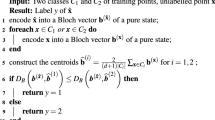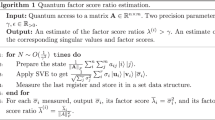Abstract
Photonic Quantum Computers provide several benefits over the discrete qubit-based paradigm of quantum computing. By using the power of continuous-variable computing we build an anomaly detection model to use on searches for New Physics. Our model uses Gaussian Boson Sampling, a #P-hard problem and thus not efficiently accessible to classical devices. This is used to create feature vectors from graph data, a natural format for representing data of high-energy collision events. A simple K-means clustering algorithm is used to provide a baseline method of classification. We then present a novel method of anomaly detection, combining the use of Gaussian Boson Sampling and a quantum extension to K-means known as Q-means. This is found to give equivalent results compared to the classical clustering version while also reducing the \( \mathcal{O} \) complexity, with respect to the sample’s feature-vector length, from \( \mathcal{O}(N) \) to \( \mathcal{O}\left(\log (N)\right) \).
Article PDF
Similar content being viewed by others
Avoid common mistakes on your manuscript.
References
T. S. Roy and A. H. Vijay, A robust anomaly finder based on autoencoders, arXiv:1903.02032 [INSPIRE].
A. Blance, M. Spannowsky and P. Waite, Adversarially-trained autoencoders for robust unsupervised new physics searches, JHEP 10 (2019) 047 [arXiv:1905.10384] [INSPIRE].
V. Mikuni and F. Canelli, Unsupervised clustering for collider physics, Phys. Rev. D 103 (2021) 092007 [arXiv:2010.07106] [INSPIRE].
M. Abdughani, J. Ren, L. Wu and J. M. Yang, Probing stop pair production at the LHC with graph neural networks, JHEP 08 (2019) 055 [arXiv:1807.09088] [INSPIRE].
J. Arjona Martínez, O. Cerri, M. Pierini, M. Spiropulu and J.-R. Vlimant, Pileup mitigation at the Large Hadron Collider with graph neural networks, Eur. Phys. J. Plus 134 (2019) 333 [arXiv:1810.07988] [INSPIRE].
J. Shlomi, P. Battaglia and J.-R. Vlimant, Graph neural networks in particle physics, Mach. Learn. Sci. Tech. 2 (2021) 021001.
P. W. Shor, Polynomial time algorithms for prime factorization and discrete logarithms on a quantum computer, SIAM J. Sci. Statist. Comput. 26 (1997) 1484 [quant-ph/9508027] [INSPIRE].
L. K. Grover, A Fast quantum mechanical algorithm for database search, quant-ph/9605043.
S. Abel, N. Chancellor and M. Spannowsky, Quantum computing for quantum tunneling, Phys. Rev. D 103 (2021) 016008 [arXiv:2003.07374] [INSPIRE].
S. Abel and M. Spannowsky, Observing the fate of the false vacuum with a quantum laboratory, P. R. X. Quantum. 2 (2021) 010349 [arXiv:2006.06003] [INSPIRE].
K. L. Ng, B. Opanchuk, M. Thenabadu, M. Reid and P. D. Drummond, The fate of the false vacuum: Finite temperature, entropy and topological phase in quantum simulations of the early universe, P. R. X. Quantum. 2 (2021) 010350 [arXiv:2010.08665] [INSPIRE].
A. Mott, J. Job, J. R. Vlimant, D. Lidar and M. Spiropulu, Solving a Higgs optimization problem with quantum annealing for machine learning, Nature 550 (2017) 375 [INSPIRE].
A. Blance and M. Spannowsky, Quantum Machine Learning for Particle Physics using a Variational Quantum Classifier, arXiv:2010.07335 [INSPIRE].
S. P. Jordan, K. S. M. Lee and J. Preskill, Quantum Computation of Scattering in Scalar Quantum Field Theories, Quant. Inf. Comput. 14 (2014) 1014 [arXiv:1112.4833] [INSPIRE].
L. García-Álvarez et al., Fermion-Fermion Scattering in Quantum Field Theory with Superconducting Circuits, Phys. Rev. Lett. 114 (2015) 070502 [arXiv:1404.2868] [INSPIRE].
S. P. Jordan, K. S. M. Lee and J. Preskill, Quantum Algorithms for Fermionic Quantum Field Theories, arXiv:1404.7115 [INSPIRE].
S. P. Jordan, H. Krovi, K. S. M. Lee and J. Preskill, BQP-completeness of Scattering in Scalar Quantum Field Theory, Quantum 2 (2018) 44 [arXiv:1703.00454] [INSPIRE].
J. Preskill, Simulating quantum field theory with a quantum computer, PoS LATTICE2018 (2018) 024 [arXiv:1811.10085] [INSPIRE].
A. H. Moosavian, J. R. Garrison and S. P. Jordan, Site-by-site quantum state preparation algorithm for preparing vacua of fermionic lattice field theories, arXiv:1911.03505 [INSPIRE].
NuQS collaboration, σ Models on Quantum Computers, Phys. Rev. Lett. 123 (2019) 090501 [arXiv:1903.06577] [INSPIRE].
NuQS collaboration, Gluon Field Digitization for Quantum Computers, Phys. Rev. D 100 (2019) 114501 [arXiv:1906.11213] [INSPIRE].
NuQS collaboration, Parton physics on a quantum computer, Phys. Rev. Res. 2 (2020) 013272 [arXiv:1908.10439] [INSPIRE].
NuQS collaboration, Suppressing Coherent Gauge Drift in Quantum Simulations, arXiv:2005.12688 [INSPIRE].
I. Márquez-Mártin, P. Arnault, G. Di Molfetta and A. Pérez, Electromagnetic lattice gauge invariance in two-dimensional discrete-time quantum walks, Phys. Rev. A 98 (2018) 032333 [arXiv:1808.04488] [INSPIRE].
P. Arrighi, G. Di Molfetta, I. Márquez-Martín and A. Pérez, Dirac equation as a quantum walk over the honeycomb and triangular lattices, Phys. Rev. A 97 (2018) 062111 [arXiv:1803.01015] [INSPIRE].
G. Jay, F. Debbasch and J. B. Wang, Dirac quantum walks on triangular and honeycomb lattices, Phys. Rev. A 99 (2019) 032113 [arXiv:1803.01304] [INSPIRE].
G. Di Molfetta and P. Arrighi, A quantum walk with both a continuous-time and a continuous-spacetime limit, arXiv:1906.04483 [INSPIRE].
H. Lamm and S. Lawrence, Simulation of Nonequilibrium Dynamics on a Quantum Computer, Phys. Rev. Lett. 121 (2018) 170501 [arXiv:1806.06649] [INSPIRE].
NuQS collaboration, Quantum Simulation of Field Theories Without State Preparation, arXiv:2001.11490 [INSPIRE].
A. Y. Wei, P. Naik, A. W. Harrow and J. Thaler, Quantum Algorithms for Jet Clustering, Phys. Rev. D 101 (2020) 094015 [arXiv:1908.08949] [INSPIRE].
K. T. Matchev, P. Shyamsundar and J. Smolinsky, A quantum algorithm for model independent searches for new physics, arXiv:2003.02181 [INSPIRE].
S. Lloyd and S. L. Braunstein, Quantum computation over continuous variables, Phys. Rev. Lett. 82 (1999) 1784 [quant-ph/9810082] [INSPIRE].
T. R. Bromley et al., Applications of near-term photonic quantum computers: software and algorithms, Quantum Sci. Technol. 5 (2020) 034010.
N. Killoran, T. R. Bromley, J. M. Arrazola, M. Schuld, N. Quesada and S. Lloyd, Continuous-variable quantum neural networks, Phys. Rev. Res. 1 (2019) 033063.
S. Aaronson and A. Arkhipov, The computational complexity of linear optics, arXiv:1011.3245.
C. S. Hamilton, R. Kruse, L. Sansoni, S. Barkhofen, C. Silberhorn and I. Jex, Gaussian boson sampling, Phys. Rev. Lett. 119 (2017) 170501.
M. Schuld, K. Brádler, R. Israel, D. Su and B. Gupt, Measuring the similarity of graphs with a gaussian boson sampler, Phys. Rev. A 101 (2020) 032314.
L. Petit et al., Universal quantum logic in hot silicon qubits, Nature 580 (2020) 355.
S. Lloyd, M. Mohseni and P. Rebentrost, Quantum algorithms for supervised and unsupervised machine learning, arXiv:1307.0411.
D. Kopczyk, Quantum machine learning for data scientists, arXiv:1804.10068.
A. Falkowski, D. Krohn, L.-T. Wang, J. Shelton and A. Thalapillil, Unburied Higgs boson: Jet substructure techniques for searching for Higgs’ decay into gluons, Phys. Rev. D 84 (2011) 074022 [arXiv:1006.1650] [INSPIRE].
C.-R. Chen, M. M. Nojiri and W. Sreethawong, Search for the Elusive Higgs Boson Using Jet Structure at LHC, JHEP 11 (2010) 012 [arXiv:1006.1151] [INSPIRE].
ATLAS collaboration, Search for Higgs boson decays into two spin-0 particles in the bbμμ final state with the ATLAS detector in pp collisions at \( \sqrt{s} \) = 13 TeV, ATLAS-CONF-2021-009 (2021).
T. Sjöstrand et al., An introduction to PYTHIA 8.2, Comput. Phys. Commun. 191 (2015) 159 [arXiv:1410.3012] [INSPIRE].
J. M. Butterworth, A. R. Davison, M. Rubin and G. P. Salam, Jet substructure as a new Higgs search channel at the LHC, AIP Conf. Proc. 1078 (2009) 189 [arXiv:0809.2530] [INSPIRE].
D. E. Soper and M. Spannowsky, Combining subjet algorithms to enhance ZH detection at the LHC, JHEP 08 (2010) 029 [arXiv:1005.0417] [INSPIRE].
S. Marzani, G. Soyez and M. Spannowsky, Looking inside jets: an introduction to jet substructure and boosted-object phenomenology, vol. 958, Springer (2019) [DOI] [arXiv:1901.10342] [INSPIRE].
D. E. Soper and M. Spannowsky, Finding top quarks with shower deconstruction, Phys. Rev. D 87 (2013) 054012 [arXiv:1211.3140] [INSPIRE].
M. Cacciari, G. P. Salam and G. Soyez, FastJet User Manual, Eur. Phys. J. C 72 (2012) 1896 [arXiv:1111.6097] [INSPIRE].
Y. L. Dokshitzer, G. D. Leder, S. Moretti and B. R. Webber, Better jet clustering algorithms, JHEP 08 (1997) 001 [hep-ph/9707323] [INSPIRE].
M. Cacciari, G. P. Salam and G. Soyez, The anti-kt jet clustering algorithm, JHEP 04 (2008) 063 [arXiv:0802.1189] [INSPIRE].
T. N. Kipf and M. Welling, Semi-Supervised Classification with Graph Convolutional Networks, arXiv:1609.02907 [INSPIRE].
F. Pedregosa et al., Scikit-learn: Machine learning in Python, J. Mach. Learn. Res. 12 (2011) 2825.
N. de Lara and E. Pineau, A simple baseline algorithm for graph classification, arXiv:1810.09155.
S. Lloyd, Least squares quantization in pcm, IEEE Trans. Inform. Theory 28 (1982) 129.
M. E. Celebi, H. A. Kingravi and P. A. Vela, A comparative study of efficient initialization methods for the k-means clustering algorithm, Expert Syst. Appl. 40 (2013) 200.
D. J. Brod, E. F. Galvão, A. Crespi, R. Osellame, N. Spagnolo and F. Sciarrino, Photonic implementation of boson sampling: a review, Adv. Photonics 1 (2019) 034001.
S. L. Braunstein and P. van Loock, Quantum information with continuous variables, Rev. Mod. Phys. 77 (2005) 513 [quant-ph/0410100] [INSPIRE].
N. Killoran, J. Izaac, N. Quesada, V. Bergholm, M. Amy and C. Weedbrook, Strawberry fields: A software platform for photonic quantum computing, Quantum 3 (2019) 129.
K. Brádler, P.-L. Dallaire-Demers, P. Rebentrost, D. Su and C. Weedbrook, Gaussian boson sampling for perfect matchings of arbitrary graphs, Phys. Rev. A 98 (2018) 032310.
L. Valiant, The complexity of computing the permanent, Theor. Comput. Sci. 8 (1979) 189.
W. R. Clements, P. C. Humphreys, B. J. Metcalf, W. S. Kolthammer and I. A. Walmsley, Optimal design for universal multiport interferometers, Optica 3 (2016) 1460.
N. Shervashidze, S. Vishwanathan, T. Petri, K. Mehlhorn and K. Borgwardt, Efficient graphlet kernels for large graph comparison, in Proceedings of the Twelth International Conference on Artificial Intelligence and Statistics, D. van Dyk and M. Welling, eds., vol. 5 of Proc. Mach. Learn. Res., pp. 488–495, PMLR, Hilton Clearwater Beach Resort, Clearwater Beach, Florida, U.S.A., 16–18 April 2009.
I. Kerenidis, J. Landman, A. Luongo and A. Prakash, q-means: A quantum algorithm for unsupervised machine learning, arXiv:1812.03584.
J. C. Garcia-Escartin and P. Chamorro-Posada, SWAP test and Hong-Ou-Mandel effect are equivalent, Phys. Rev. A 87 (2013) 052330.
V. Bergholm et al., Pennylane: Automatic differentiation of hybrid quantum-classical computations, arXiv:1811.04968.
Author information
Authors and Affiliations
Corresponding author
Additional information
Publisher’s Note
Springer Nature remains neutral with regard to jurisdictional claims in published maps and institutional affiliations.
ArXiv ePrint: 2103.03897
Rights and permissions
Open Access . This article is distributed under the terms of the Creative Commons Attribution License (CC-BY 4.0), which permits any use, distribution and reproduction in any medium, provided the original author(s) and source are credited.
About this article
Cite this article
Blance, A., Spannowsky, M. Unsupervised event classification with graphs on classical and photonic quantum computers. J. High Energ. Phys. 2021, 170 (2021). https://doi.org/10.1007/JHEP08(2021)170
Received:
Revised:
Accepted:
Published:
DOI: https://doi.org/10.1007/JHEP08(2021)170




